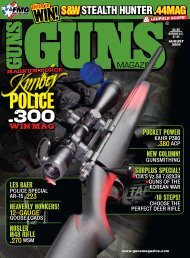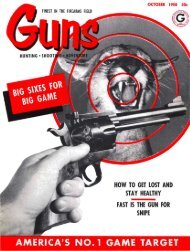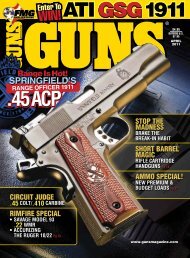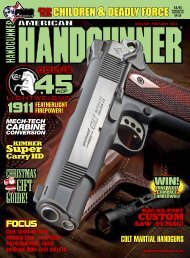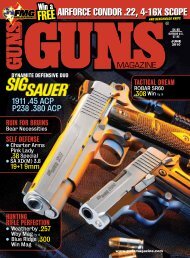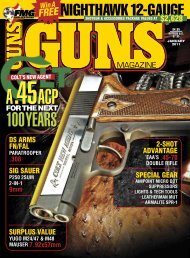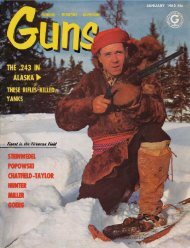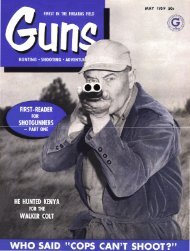Guns 2012-08.pdf - Jeffersonian
Guns 2012-08.pdf - Jeffersonian
Guns 2012-08.pdf - Jeffersonian
Create successful ePaper yourself
Turn your PDF publications into a flip-book with our unique Google optimized e-Paper software.
STORY: Hamilton S. Bowen<br />
Measuring Tools<br />
They’re needed for<br />
many shooting endeavors.<br />
Believe it or not, human beings do not think about<br />
sex every waking moment. The other 10 percent of<br />
our contemplative time is given over to pondering topics<br />
like money, margaritas, why we are here or, in some rare<br />
cases, the physical characteristics of our world. For gun<br />
junkies, that world encompasses a lot of speculation<br />
on height, width, diameter, distance, various spatial<br />
relationships, etc. We’ll contemplate here a few of the<br />
necessary tools useful in the satisfaction of our curiosity.<br />
You do not have to be a practicing mortals can buy. The better ones<br />
gunsmith to need measuring tools. will measure precisely, repeatably in<br />
Shooters are always measuring group<br />
sizes, hole spaces for scope mounts<br />
of peep sights, length of pull and so<br />
on. If you are a reloader, then you are<br />
constantly measuring case lengths,<br />
.0001" increments. Since more precise<br />
measurements are an indicator of<br />
importance, this is one place not to<br />
scrimp on quality. You get exactly<br />
what you pay for so expect to pay<br />
bullet diameters, head diameters, $100 to $200 for a good one. If you<br />
case wall thickness and the like. How<br />
sophisticated your tools are depends on<br />
the job to hand. Measuring cartridge<br />
case length with a plastic caliper is fine.<br />
Measuring case head expansion for<br />
pressure signs requires a high-quality<br />
blade micrometer graduated in .0001"<br />
procure only one, the standard 0-1"<br />
with flat anvil and spindle faces is the<br />
most important. While digital tools are<br />
now all the vogue, there is something<br />
inelegant about them that leaves me<br />
cold and uninspired. I like pretty stuff,<br />
including tools.<br />
increments.<br />
Alas, not everything can be<br />
Micrometers are the most measured between a couple of flats<br />
accurate hand measuring tools we so micrometers come in a variety<br />
Can’t have too<br />
many measuring<br />
tools around.<br />
This pair of micrometers—tubing and blade<br />
types—are used as often at the reloading bench<br />
as the workbench.<br />
of styles. The most important other<br />
micrometer for use around a gun<br />
shop or the reloading bench is the<br />
tubing micrometer which has ball<br />
anvil and a flat spindle for measuring<br />
tube wall thickness or hole distances<br />
from edges. Their obvious lower limit<br />
on measurements is governed by<br />
ball diameter. I use mine regularly to<br />
measure cartridge case wall thickness.<br />
Another helpful specialty micrometer<br />
is the blade type for measuring into<br />
narrow spaces like grooves or slots.<br />
Mine has been used more for measuring<br />
cartridge case web expansion at the<br />
head in search of pressure-related<br />
changes. Depth micrometers are critical<br />
for measuring and setting headspace<br />
when re-barreling a rifle.<br />
Tricky Stuff<br />
Measuring inside diameters is<br />
trickier. Often, the simplest way to<br />
measure hole diameters is with pin<br />
gauges. Precise internal measurements<br />
that would otherwise require some<br />
exceedingly costly inside micrometers<br />
can be determined to within a few ten<br />
thousandths with simple pin gauges<br />
available in .0005" size increments.<br />
There are several tolerance types. The<br />
handiest for most of us is the -.0002"<br />
meaning that the pin is actually .0002"<br />
smaller than indicated. If a .4530" pin<br />
will pass through a hole but a .4535"<br />
pin will not, you can be pretty sure the<br />
hole is somewhere between .4530" and<br />
.4535" since there must be a few tenths<br />
of clearance for even a tight slip fit.<br />
Not many things measured in a gun<br />
shop need be determined that closely.<br />
22<br />
WWW.GUNSMAGAZINE.COM • AUGUST <strong>2012</strong>




